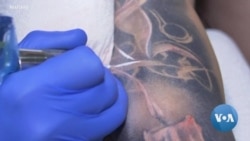ໃນອະນາຄົດ, ການສັກລາຍອາດຈະບໍ່ເປັນພຽງວິທີສຳລັບຄົນບາງຄົນ ທີ່ຈະສະແດງ
ຄວາມຮູ້ສຶກ ຂອງຕົນເອງອອກມາເທົ່ານັ້ນ, ມັນຍັງອາດຖືກໃຊ້ເພື່ອຕິດຕາມສະພາບ
ທາງພັນທຸກຳ ຫຼື ແມ່ນກະທັ້ງຄວບຄຸມອຸປະກອນອົງຄະທຽມນຳດ້ວຍ. ນັກຂ່າວວີໂອເອ
ເຄວິນ ອີນັອກສ໌ ມີລາຍງານ, ເຊິ່ງ ພຸດທະສອນ ຈະນຳລາຍລະອຽດມາສະເໜີທ່ານ
ໃນອັນດັບຕໍ່ໄປ.
ມັນມີການຄາດກັນວ່າ ຄົນປະມານ 1 ໃນທຸກ 5 ຄົນໃດ ໃນທົ່ວໂລກມີລາຍສັກ.
ແຕ່ບັນດານັກຄົ້ນຄວ້າໃນປະເທດ ປອກຕຸຍການ ແມ່ນກຳລັງເຮັດໃຫ້ສັກລາຍເປັນ
ເລື່ອງກ່ຽວກັບວິທະຍາສາດຫຼາຍກວ່າ ສິລະປະຕາມຮ່າງກາຍ.
ທ່ານ ມາກມູດ ທາວາໂຄລີ ຈາກມະຫາວິທະຍາໄລ ກວາມບຣາ ໄດ້ກ່າວວ່າ “ເປັນ
ຄັ້ງທຳອິດ, ທີ່ພວກເຮົາສາມາດສ້າງວິທີທີ່ອະນຸຍາດໃຫ້ພວກເຮົາ ໃຊ້ຈັກ ສັກລາຍ
ແຕັ້ມຜິວໜັງອີເລັກໂທຣນິກທີ່ສາມາດຢືດໄດ້ເປັນຢ່າງສູງ ທີ່ມັນສາມາດ ສົ່ງຫາຜິວ
ໜັງຂອງມະນຸດໄດ້, ຄ້າຍຄືກັບຮູບສັກລາຍຂອງເດັກນ້ອຍ.”
ລາຍກຳລັງຖືກສັກໃສ່
ແລ້ວປົກມັນດ້ວຍໂລຫະປະສົມເຫຼັກແຫຼວ
ນັ້ນຈະນຳພາສະແສໄຟຟ້າ
ມັນໄດ້ຖືກຈຸ່ມລົງໃນນໍ້າ.
ແລ້ວເອົາມາແປະໃສ່ຜິວໜັງຄືກັບສັກລາຍຊົ່ວຄາວ. ມັນມີລາຄາຖືກ ແລະ ກໍງ່າຍ.
ທ່ານ ມາກມູດ ກ່າວວ່າ “ສິ່ງທີ່ໃໝ່ໃນວີທີຂອງພວກເຮົານັ້ນ ແມ່ນການປະດິດ ເທັກ
ໂນໂລຈີ ເພາະວ່າວິທີກ່ອນໜ້ານີ້ ກ່ຽວກັບ ການປະດິດເຄື່ອງອີເລັກໂທຣ ນິກທີ່ສາ
ມາດຢືດໄດ້ແມ່ນແພງຫຼາຍ, ຕ້ອງໃຊ້ແຮງງານຫຼາຍ ແລະ ຊັບຊ້ອນ.”
ເມື່ອເອົາມັນແປະໃສ່ຜິວໜັງແລ້ວ, ມັນສາມາດອ່ານ ແລະ ສົ່ງສັນຍານໄຟຟ້າ ໄດ້.
ສິ່ງນີ້ອາດເປັນການກ້າວກະໂດດໄປໜ້າ ໃນການປິ່ນປົວຄົນ ທີ່ມີໂຣກຕ່າງໆ ທີ່ມີຜົນ
ກະທົບຕໍ່ລະບົບປະສາດຂອງເຂົາເຈົ້າ.
ທ່ານ ມາກມູດ ກ່າວວ່າ “ຖ້າພວກເຮົາເອົາລາຍພວກນີ້ແປະໃສ່ຜິວໜັງ, ແລ້ວ ພວກ
ເຮົາຈະສາມາດກະຕຸ້ນກ້າມເນື້ອ ຫຼື ເສັ້ນປະສາດຕ່າງໆ. ມັນອາດມີປະ ໂຫຍດສຳ
ລັບອາການຂອງຄົນໄຂ້ບາງຄົນ ທີ່ມີຄວາມຜິດປົກກະຕິທາງລະບົບ ເສັ້ນປະສາດ.
ຕົວຢ່າງ, ຄົນຜູ້ທີ່ໄດ້ຮັບບາດເຈັບໄຂສັນຫຼັງ ຈະສາມາດກັບມາ ຍ່າງໄດ້ອີກຄັ້ງ.”
ມັນຍັງຈະສາມາດຊ່ວຍໃຫ້ຄົນທີ່ແຂນຂາກຸດ ຄວບຄຸມແຂນຂາທຽມຂອງເຂົາເຈົ້າ
ດ້ວຍການປະຕິບັດເປັນເນື້ອເຫຍື່ອປະສາດທຽມ.
ທ່ານນາງ ຄາແມລ, ມາຈິດີ ຈາກມາຫາວິທະຍາໄລ ຄາເນກີ ແມລລັອນ ກ່າວ ວ່າ
“ການເບິ່ງແຍງສຸຂະພາບ ແມ່ນແອັບພລີເຄຊັນທີ່ພວກເຮົາໄດ້ເພັ່ງເລັງໃສ່ ແທ້ໆ. ອີກ
ຂົງເຂດນຶ່ງທີ່ຫ້ອງທົດລອງຂອງຂ້າພະເຈົ້າໄດ້ເພັ່ງເລັງໃສ່ ຈະແມ່ນ ການພົວພັນ ລະ
ຫວ່າງ ມະນຸດ ກັບ ເຄື່ອງຈັກ ແລະ ການຄົ້ນຄວ້າ ກ່ຽວກັບ ຫຸ່ນຍົນຫຼາຍກວ່າ. ສະນັ້ນ
ວັດຖຸພວກນີ້ຄືຂ້າພະເຈົ້າໄດ້ເວົ້າກ່ອນມາແລ້ວ, ຍັງມີ ແອບພລີເຄຊັນເຊັ່ນ ຜິວໜັງ
ທຽມ ແລະ ເນື້ອເຫຍື່ອປະສາດທຽມເຊັ່ນກັນ.”
ແລະ ໃນເມື່ອແອບພລີເຄຊັນດັ່ງກ່າວແມ່ນໃຊ້ຊົ່ວຄາວເທົ່ານັ້ນ, ການມີໄວ້ອັນ ນຶ່ງກໍບໍ່
ເຈັບຫຼາຍ ເທົ່າການສັກລາຍແທ້.
In the future, a tattoo may not only be a way for someone to express themselves, it may also be used to monitor a genetic condition or even control a prosthetic device. VOA's Kevin Enochs reports.
It's estimated that about one in five people around the world have a tattoo.
But researchers in Portugal ....
...are making tattoos that are more about science than body art.
"For the first time, we have created a method that allows us inkjet printing of highly strechable electronic skin that can be transferred to the human skin, similar to the kids' temporary tattoos."
The tattoo is printed....
Then covered with a liquid metal alloy....
That conducts electricity.
It's Immersed in water....
then applied to the skin just like a temporary tattoo. It's a cheap and easy.
"What's new in our method is the fabrication technology because previous methods of fabrication of stretchable electronics were costly, labor intensive and complex."
Once applied to the skin, it can read or send electric signals.
This could be a great leap forward in treating people with diseases that affect their nervous system..
"If we place these tattoos over the skin, then we can stimulate muscles or nerves. This can be useful for some patient conditions, with neurological disorders. For instance, people with spinal cord injuries would be able to walk again."
It could also help amputees manipulate their prosthetics by acting as artificial nerve tissue.
"Healthcare is the application we're really focused on. Another area of my lab is more generally focused on human-machine interaction and soft robotics. So these materials like I said before, also have applications such as artificial skin and artificial nervous tissues."
And since the application is temporary, getting one is way less painful than getting a real tattoo.





